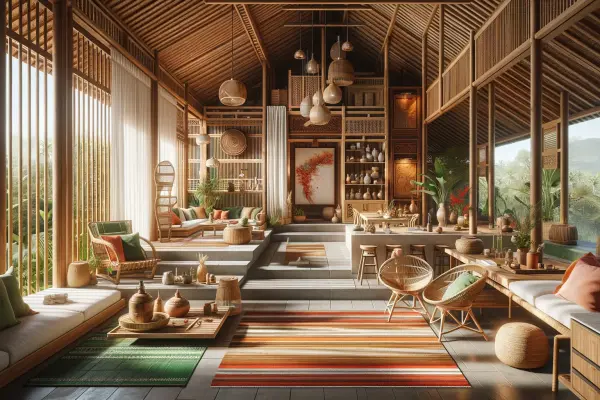Have you ever wondered what it would be like to return to a peaceful tropical oasis every day? Modern Balinese interior design allows you to create precisely this atmosphere, combining exotic Balinese aesthetics in design with the functionality of modern solutions. This unique balance of natural materials, light interior shades, and minimalism in details is winning the hearts of designers and connoisseurs of harmonious spaces worldwide. A tropical Balinese interior in an apartment or house is not just a fashionable trend but a genuine philosophy that allows you to create a corner for relaxation and unity with nature.
According to Pinterest research, searches for "Balinese interior style" have increased by 35% over the past year, and it's no wonder – who doesn't dream of a piece of tropical paradise in their own home? Let's dive into the world of modern Balinese design and learn how to create an authentic island atmosphere without leaving your apartment. You can order a Balinese-style design from professionals or create it yourself by following our recommendations.
Key Features of Balinese Style
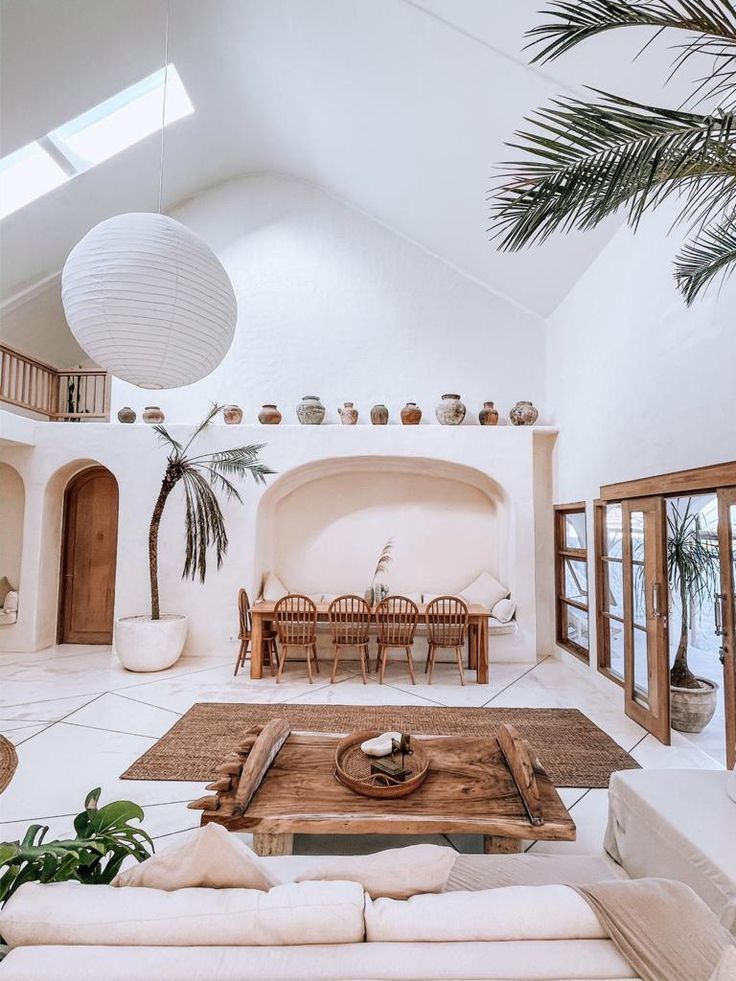
Balinese style in interior design and architecture is distinguished by certain characteristic features that reflect the cultural and natural aspects of the island of Bali. Indonesian design creates a unique and harmonious atmosphere of tropical Balinese interior that attracts enthusiasts of this style from around the world. Balinese culture in interior design is expressed through characteristic elements, forms, and materials.
"Modern Balinese interior is the perfect balance between Western functionality and Eastern aesthetics. The main rule is to create a sense of space and airiness while maintaining coziness and harmony with nature," notes Max Jenquel, a famous interior designer specializing in tropical style decoration.
Understanding the basic principles of Balinese aesthetics in design will help you properly integrate elements of island style into your home. Here are the key characteristics that define the authenticity of modern Balinese design:
- Use of natural materials - noble wood (teak and suar) in furniture, bamboo and rattan in accessories, pebbles and stone in finishing. Practical advice: choose furniture and finishes with pronounced texture and natural imperfections that emphasize the connection with nature.
- Abundance of handmade items in decor and furniture. Balinese woven furniture and carved wooden elements add individuality to the interior. Practical advice: even one or two authentic handmade items can become central elements of the space.
- Minimalism in Balinese style and absence of unnecessary details creates a sense of space. Practical advice: regularly conduct a "revision" of your decor, keeping only significant and quality items.
- Predominance of open space in Balinese style for natural lighting and ventilation. Practical advice: remove unnecessary partitions, use sliding doors or light screens instead of solid walls.
- Tropical plants in interior – living plants strengthen the connection with nature. Practical advice: group plants of different heights, creating multi-level compositions.
- Elegant Balinese wooden furniture with emphasis on wood texture in design. Practical advice: choose solid wood furniture with minimal processing that preserves the natural wood pattern.
- Light interior shades with accent bright colors. Practical advice: use 80% neutral tones (beige, milky, gray) and 20% bright accents (emerald, terracotta, deep blue).
Applying these principles of Balinese interior style, you will create the foundation for an authentic space that will be not only aesthetically appealing but also functional. It's important not just to copy individual elements but to understand the philosophy of Balinese culture in interior design – respect for nature, simplicity, and harmony with the surrounding space.
Color Palette and Materials in Balinese Style
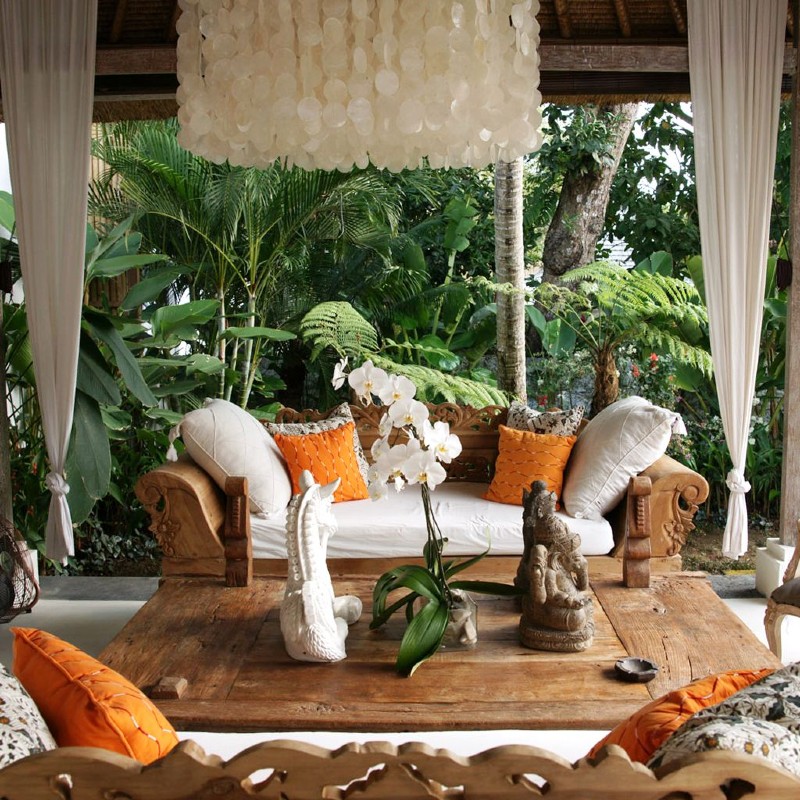
Color palette and choice of materials play a key role in creating a unique modern interior in Balinese style. These elements bring uniqueness and a special atmosphere characteristic of Bali Island to the design, contributing to the creation of a true tropical oasis in your home.
Modern Balinese design is characterized by both light interior shades (beige, milky, sandy) and bright accents: all shades of green, terracotta, orange, gold. These colors reflect the richness of tropical aesthetics, creating a sense of warmth and tranquility characteristic of the Balinese home atmosphere.
| Material Type | Application in Interior | Features | Practical Tips |
|---|---|---|---|
| Teak | Furniture, floors, wall finishes | Moisture resistant, ideal for bathrooms | Treat with oil, not varnish, to preserve the natural look and texture |
| Suar | Countertops, consoles, decorative elements | Expressive texture with dark streaks | Use countertops from solid cuts for maximum effect |
| Bamboo | Partitions, blinds, decor | Light, eco-friendly, creates airiness | Treat with special compounds against insects |
| Rattan | Woven furniture, baskets, lamps | Durable, flexible, with unique weaving | Protect from direct sunlight to prevent fading |
| Natural stone | Floors, bathroom walls, decor | Creates natural coolness and texture | Choose stones with uneven surfaces for an authentic effect |
| Pebbles | Bathroom finishes, decorative elements | Massage effect, natural aesthetics | Use pebbles in shower areas for foot massage |
This table demonstrates the main natural materials for renovation in Balinese style with practical advice on their use and integration into modern interiors. When choosing materials, pay attention not only to appearance but also to practicality and durability – a true tropical Balinese interior is created for comfortable everyday life, not just for beauty.
In modern Balinese style design, natural textures with textured finishes predominate: exotic wood, bamboo, rattan, stone, porcelain stoneware resembling stone, ceramics, cotton, and silk. Using these eco-friendly materials not only emphasizes the authenticity of the style but also adds warmth and coziness to the interior, creating wooden accents in design.
Here are practical tips for integrating natural materials into modern interiors:
- Woven products and curtains from natural fibers: choose quality weaving with a clear pattern, avoid synthetic imitations that quickly lose their appearance.
- Products from noble wood: invest in quality solid wood items – they will serve for decades and acquire a noble patina over time.
- Bamboo furniture and accessories: use treated bamboo that won't delaminate or crack over time.
- Textured Balinese tiles: to save budget, you can use quality porcelain stoneware for Balinese interiors that imitates natural stone, but for accent areas, it's better to choose real stone.
Isn't it amazing how combining the right materials and light interior shades can completely transform your space? Balinese aesthetics in design proves that to create a tropical oasis atmosphere, it's enough to skillfully select natural components and place the right color accents.
Decor and Accessories in Balinese Style
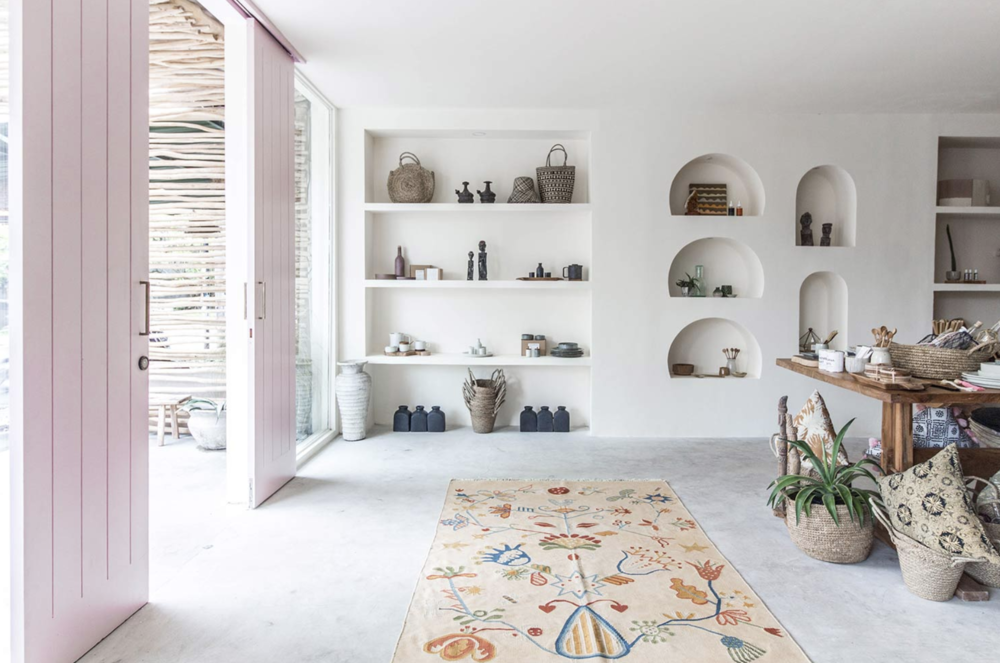
Balinese ornaments and authentic Balinese materials in decor play a key role in creating a tropical paradise atmosphere. Modern Balinese interior is characterized by simple decorative handmade elements that give the space ethnic charm and uniqueness, reflecting Balinese culture in the interior.
"In Balinese style, it's not the quantity of details that matters, but their quality and authenticity. One well-chosen decor element with history and soul can transform the entire space and create that unique Balinese home atmosphere that is so difficult to describe in words," says Maria Wong, an interior designer specializing in Asian aesthetics.
Looking for practical ways to add Balinese style to an apartment through decor? These key elements will help create authentic tropical aesthetics without unnecessary expenses:
- Batik pillows and textiles for Balinese interiors: choose natural fabrics with traditional patterns, but in a modern interpretation so they harmoniously fit into the apartment.
- Carved masks and figurines: place them at eye level, illuminate with soft directional light to highlight texture and create interesting shadows.
- Ceramic items with bright paintings: use them functionally – as flower vases, candlesticks, or fruit bowls, not just as decor.
- Woven baskets for interior: use them to store blankets, magazines, or plants, combining aesthetics and practicality.
- Balinese style lamps: place them at different heights, creating multi-level lighting, use warm light bulbs (2700-3000K).
- Tropical home decor: group live plants in sets of 3-5 of different heights, creating a natural composition, as in a tropical forest.
- Decorative elements with Balinese ornaments: use them precisely, for example, a carved wooden panel as a headboard or an accent detail on the wall.
These practical recommendations will help you properly integrate Balinese decorative elements into a modern living space, creating a functional and harmonious interior. Remember that each element should not only decorate but also provide practical benefits, which is the basis of Balinese aesthetics in design.
Where to buy Balinese style decor? Today it can be found both in specialized stores of ethnic goods and on marketplaces where craftsmen offer authentic handmade products. The price-quality ratio in this case is extremely important – it's better to purchase a few truly quality items than many cheap imitations.
Here's a real example of successful application of Balinese decor in a modern apartment:
Michael, a designer from Barcelona, transformed his small urban apartment of 60 m² using principles of tropical style decoration. He chose a neutral beige palette for walls and floors, added a teak console with expressive texture, and placed strategically important accents: woven rattan lamps, three large monsteras in ceramic pots, and a small collection of wooden statues brought from Bali. "The secret is not to overload the space," says Michael. "Ten quality authentic items will create a more convincing Balinese style than a hundred faceless souvenirs." His apartment has become a popular location for photo shoots and a source of inspiration for other designers.
Balinese ethnic elements in the interior should be felt but not dominate – this is a key principle of the modern approach to this style. This is how you will create a truly harmonious space with a Balinese home atmosphere.
Features of Furniture and Textiles in Balinese Style
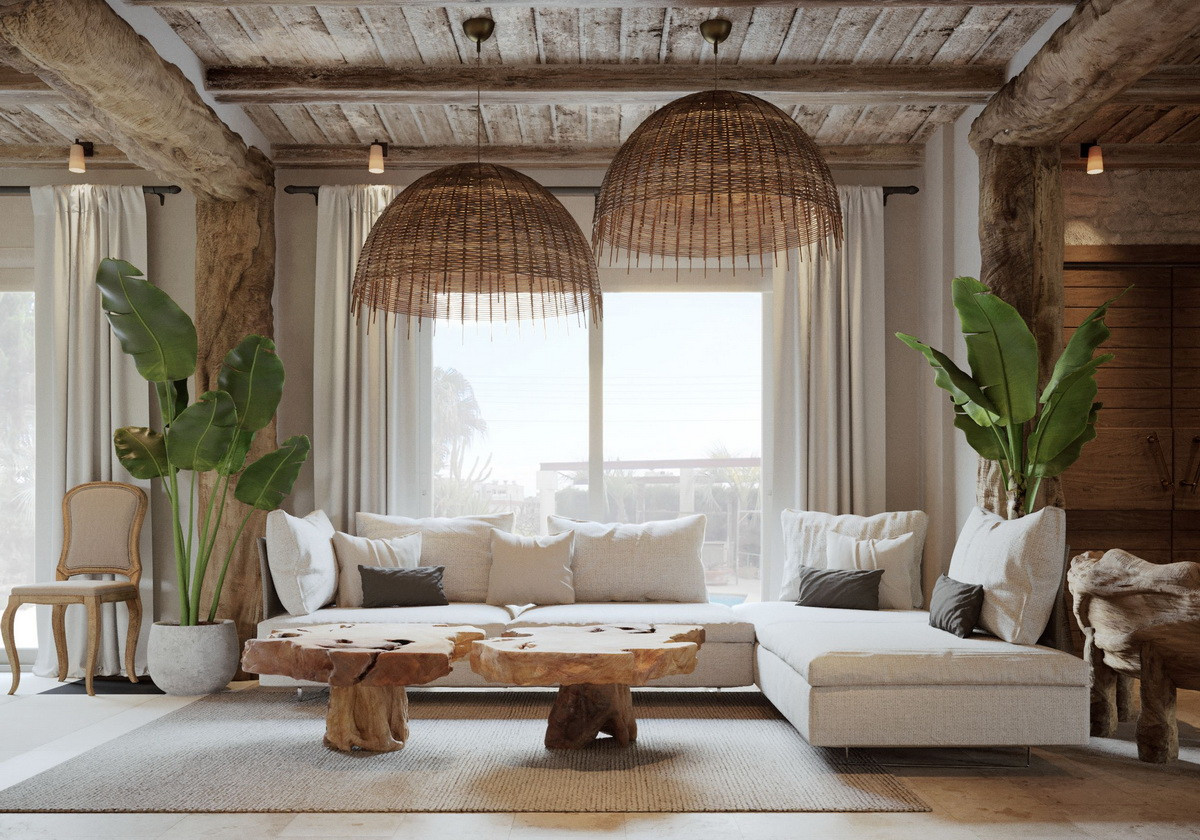 Furniture in Balinese style is distinguished by simple forms, often asymmetrical design, and mandatory use of organic components. Exotic wood, suar in design, bamboo furniture, and woven rattan products are the main materials that form the unique appearance of Balinese space.
Furniture in Balinese style is distinguished by simple forms, often asymmetrical design, and mandatory use of organic components. Exotic wood, suar in design, bamboo furniture, and woven rattan products are the main materials that form the unique appearance of Balinese space.
To create an authentic feeling of a tropical retreat while ensuring the functionality of modern housing, pay attention to these practical recommendations for choosing and placing furniture:
- Canopy beds: if ceilings are lower than 2.7 m, choose a lightweight version with textile only at the headboard or with a light wooden frame without massive elements.
- Balinese wooden furniture: choose items with open areas of wood texture, protect them with special natural oils once every 6-12 months to preserve appearance.
- Low tables for sitting on the floor: complement them with comfortable cushions with dense filler that won't sag when used.
- Carved dressers and shelves: place them not flush against the wall, but with a small gap to emphasize volume and create a play of shadows, enhancing the visual effect of carving.
- Hanging woven chairs: when installing, use ceiling anchors designed for a load of at least 150 kg, and regularly check their condition for safety.
These practical tips will help you not only create an attractive tropical Balinese interior but also ensure the durability and safety of all furniture elements in Balinese style. When choosing furniture, consider not only aesthetics but also functionality and quality of manufacture.
Textiles play a special role in forming the softness and comfort of Balinese interiors. Preference is given exclusively to natural materials – cotton, linen, silk, jute, often with ethnic prints or tropical motifs. Can you create a Balinese home atmosphere without the right textiles? Definitely not! Pillows with Balinese ornaments, bedspreads with ethnic motifs, light curtains from natural fabrics – all this creates that unique atmosphere of a tropical island.
Practical recommendations for textiles in Balinese interiors:
- Choose cushion covers with removable pillowcases – this will simplify care and interior updates.
- For curtains, use light fabrics that let light through but protect from direct sunlight – linen, cotton, thin bamboo.
- Combine different textures in the same color scheme – rough weaving, smooth cotton, textured linen to create depth and interest.
- Use textiles with color gradient or sun-faded fabric effect – this will create an authentic "island" mood.
- Place small textile accents (napkins, runners) on wooden surfaces to highlight their texture and protect from damage.
The color scheme of textiles can vary from neutral Balinese shades to bright accents in the form of pillows or blankets in rich tropical colors. Remember that in modern Balinese interiors, textiles should be of high quality and tactilely pleasant – this is one of the foundations of the comfort philosophy that this style follows.
How to Combine Balinese Style with Modern Interior
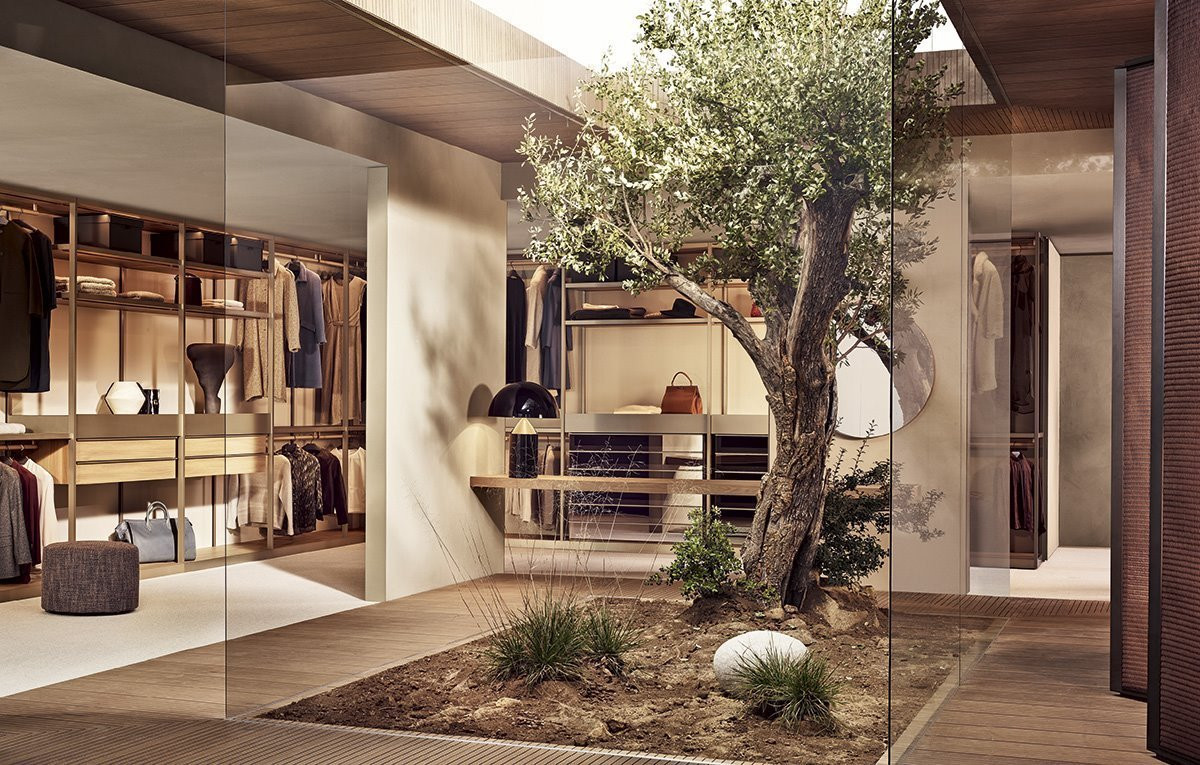 The modern world of design increasingly turns to combining different stylistic directions. Minimalist tropical design is exactly what results from the skillful fusion of modern minimalism and Balinese traditions in design. How to achieve this harmonious union in an ordinary apartment?
The modern world of design increasingly turns to combining different stylistic directions. Minimalist tropical design is exactly what results from the skillful fusion of modern minimalism and Balinese traditions in design. How to achieve this harmonious union in an ordinary apartment?
Here are proven strategies for integrating Balinese elements into modern interiors:
- Start with the base: choose light interior shades for walls, floors, and large furniture pieces, creating a clean canvas for Balinese accents.
- Introduce elements of tropical aesthetics gradually: start with 3-5 key items (woven lamp, wooden panel, large plant), evaluate the effect, then add new elements if necessary.
- Combine modern technology with eco-friendly materials: hide TVs in niches or behind sliding wooden panels, choose equipment in neutral color cases.
- Use the "focal point principle": in each room, create 1-2 bright Balinese accents that attract attention, leaving the rest of the space calm.
- Adapt proportions: if traditional Balinese furniture is too massive for your space, look for modern interpretations with the same aesthetics but lighter proportions.
- Provide multi-level lighting: use a combination of hanging lamps, floor lamps, and candles, creating a warm, relaxing interior atmosphere.
- Integrate smart technologies inconspicuously: use "smart home" systems to control lighting, climate, and sound, maintaining visual cleanliness of the space.
| Room | Modern Solutions | Balinese Elements | Practical Integration Tips |
|---|---|---|---|
| Living Room | Minimalist furniture, smart technology | Wooden accents in design, woven elements | Use a modern neutral-colored sofa, complemented with pillows with Balinese motifs; purchase a coffee table made of solid teak |
| Bedroom | Built-in storage systems, ergonomic bed | Wooden headboard, natural textiles | Order a carved wooden panel as a headboard for a modern bed; use light curtains made of natural materials |
| Bathroom | Modern plumbing, functional storage systems | Pebbles in bathroom, textured Balinese tiles | Create a shower area with pebble finishing; add shelves made of moisture-resistant teak; use stone-like porcelain stoneware on the floor |
| Kitchen | Modern appliances, ergonomic layout | Open teak shelves, natural accessories | Replace some of the hanging cabinets with open wooden shelves; use wooden cutting boards and accessories as decor |
This table offers specific practical recommendations for integrating Balinese elements into various rooms of a modern house or apartment. Use these tips as a starting point, adapting them to your specific conditions and preferences. Remember that the main goal is to create a space that will be not only aesthetically appealing but also convenient for everyday life.
How to combine Balinese style with minimalism? The secret is in choosing quality materials with expressive texture, a restrained color palette, and avoiding unnecessary details. Use the principle of "less, but better" – several large, significant items in Balinese style surrounded by minimalist furnishings will create a more harmonious interior than many small decorative elements.
The main thing when combining styles is to maintain balance and a sense of proportion. Modern Balinese interior should not look like a literal reproduction of a rural house in Bali or like a faceless hotel room with a couple of ethnic accessories. Strive for harmonious fusion, where modern and traditional elements complement each other, creating a holistic and functional space.
How to Design a Bedroom in Balinese Style
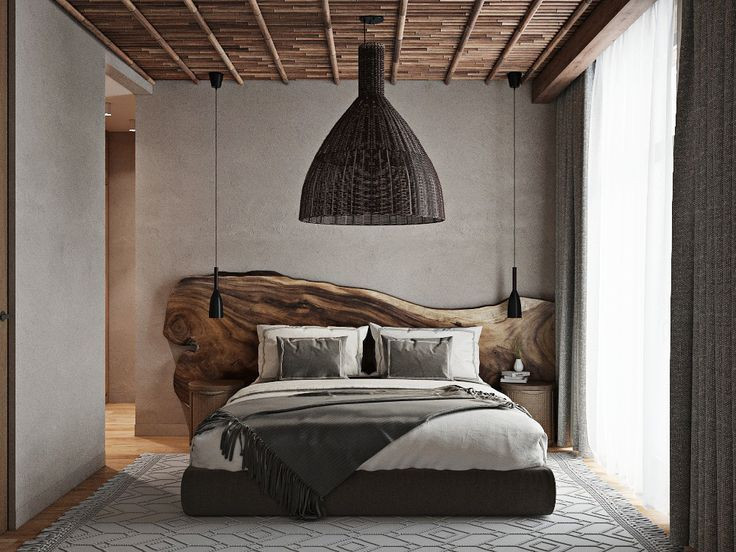 The bedroom is an ideal place to embody Balinese style, as this is where the atmosphere of relaxation and tranquility is especially important. You can create a tropical oasis for rest by following several basic principles.
The bedroom is an ideal place to embody Balinese style, as this is where the atmosphere of relaxation and tranquility is especially important. You can create a tropical oasis for rest by following several basic principles.
Key elements for designing a bedroom in Balinese style:
- Natural bed: choose a solid wood bed, preferably with carved elements or an ethnic-style headboard. For complete authenticity, you can install a canopy made of light cotton or linen.
- Textiles with soft textures: use quality bedding made of natural materials (cotton, linen, bamboo) in neutral shades, complementing it with 2-3 decorative pillows with Balinese ornaments or tropical prints.
- Proper lighting: create a multi-level system with main soft ceiling light, wall lamps with warm light, and table lamps with shades made of natural materials.
- Plants: place 2-3 large tropical plants (monstera, palm, ficus) and several small ones (orchids, air ferns) in the bedroom to create a tropical retreat effect.
- Minimal decor: limit yourself to 1-2 significant art pieces – a carved wooden panel on the wall, a ceramic vase, or an authentic sculpture.
The color scheme of a bedroom in Balinese style should promote relaxation: choose light shades (white, beige, light gray) for walls and ceiling, natural wood tones for furniture and floor, with possible accents of deep natural tones (emerald, terracotta, indigo) in textiles and accessories.
Practical tips for creating the perfect Balinese-style bedroom:
- Position the bed so that it offers a view of the most attractive interior element or window. If this is not possible, create a focal point in the form of a beautiful panel or impressive plant.
- Choose bedside tables made of solid wood with open shelves to display a minimum of thoughtfully selected accessories.
- Use mirrors in wooden or woven frames to visually expand the space and reflect greenery.
- Instead of a classic carpet, use natural mats made of jute, sisal, or seaweed for warmth and texture.
- Add aromatic elements characteristic of Bali – sandalwood sticks, diffusers with lemongrass or frangipani scent to create a comprehensive sensory experience.
Remember that the main goal when designing a bedroom in Balinese style is to create a space that promotes deep relaxation and rejuvenation, reflecting the philosophy of the Balinese way of life with its respect for nature and value of harmony.
Conclusion
Modern interior in Balinese style is not just a collection of exotic items and decor, but a holistic philosophy of space organization, in which each element has its practical and aesthetic significance. By creating such an interior, you are not just following a fashionable trend, but forming a special atmosphere that promotes relaxation, harmony, and rejuvenation.
Key principles to remember when working with Balinese style in a modern context: use quality natural materials with pronounced texture; prioritize functionality and comfort; integrate living plants as a full-fledged design element; create multi-level soft lighting; combine a neutral base with bright accents; avoid overloading with details, focusing on quality rather than quantity.
Start transforming your space from small – choose one room or even an area to experiment with Balinese aesthetics. Create a neutral foundation, add 3-5 key elements (woven lamp, quality wooden furniture piece, group of tropical plants, textiles with ethnic pattern), and you will see how the atmosphere of the space changes. Gradually expand the style to other rooms, maintaining the integrity and harmony of the interior.
Remember the main thing: the true value of Balinese style is not in expensive accessories, but in creating a space that reflects respect for nature, attention to detail, and aspiration for a harmonious, conscious life. Such an interior doesn't just please the eye – it changes the quality of everyday experience, reminding of the importance of balance, natural beauty, and genuine comfort.
